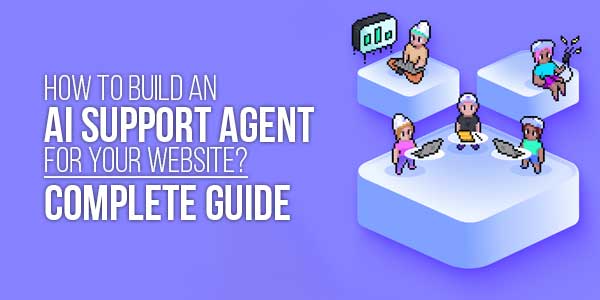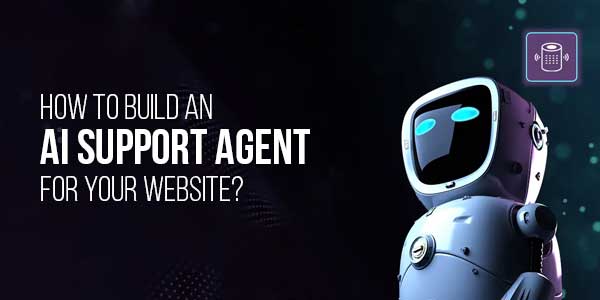
Table of Contents
How To Make An AI Support Agent For A General Website
In today’s digital landscape, providing instant support to website visitors isn’t just nice-to-have—it’s essential. An AI support agent can handle common queries 24/7, reduce response times, and significantly improve customer satisfaction. This comprehensive guide will walk you through creating your own AI-powered support agent from scratch.
Understanding AI Support Agents
Before diving into development, it’s crucial to understand what an AI support agent is and how it functions. These intelligent systems combine natural language processing (NLP), machine learning, and sometimes even voice recognition to simulate human-like conversations.
“AI-powered customer service solutions can reduce support costs by up to 30% while improving response times and customer satisfaction scores.” – Gartner Research
Key Benefits Of AI Support Agents
- 24/7 availability without additional staffing costs
- Instant responses to common customer queries
- Ability to handle multiple conversations simultaneously
- Continuous learning from customer interactions
- Seamless handoff to human agents when needed
Planning Your AI Support Agent
Successful AI implementation begins with careful planning. Rushing into development without proper preparation often leads to ineffective solutions that frustrate rather than help users.
Define Your Objectives
Start by identifying what you want your AI agent to accomplish. Common objectives include:
- Answering frequently asked questions
- Guiding users through troubleshooting processes
- Collecting preliminary information before human handoff
- Providing product recommendations
- Assisting with order tracking and returns
Analyze Customer Interactions
Review existing customer support tickets, live chat logs, and emails to identify:
- The most common questions and issues
- Language patterns and terminology your customers use
- Points where customers typically need assistance
- Complex queries that might require human intervention
Choosing The Right Technology Stack
Selecting appropriate technologies forms the foundation of your AI support agent. The ideal stack depends on your technical capabilities, budget, and specific requirements.
Natural Language Processing (NLP) Engines
Consider these popular NLP platforms:
- Dialogflow (Google): User-friendly with good integration options
- IBM Watson Assistant: Enterprise-grade with advanced features
- Microsoft Bot Framework: Excellent for Azure ecosystem integration
- Rasa Open Source: For developers wanting complete control
Development Frameworks
If you’re building from scratch, these frameworks can help:
- Python with NLTK or spaCy for NLP
- Node.js for backend services
- React or Vue.js for the frontend interface
Building The Knowledge Base
Your AI agent is only as good as the information it can access. Creating a comprehensive knowledge base is critical for effective performance.
Content Organization
Structure your knowledge base logically:
- Create categories based on user needs (e.g., billing, technical support)
- Develop a hierarchy from general to specific information
- Include multiple variations of questions for the same answer
Training Data Preparation
Prepare training data that includes:
- Common customer queries (at least 50-100 variations per intent)
- Appropriate responses for each intent
- Contextual follow-up questions
- Fallback responses for unrecognized queries
Developing The Conversation Flow
A natural conversation flow keeps users engaged and improves resolution rates. Poorly designed flows frustrate users and increase escalations to human agents.
Designing Dialog Trees
Create logical paths for conversations:
- Start with a friendly greeting and offer of assistance
- Progress through clarifying questions when needed
- Provide clear, concise answers
- Offer follow-up options or next steps
Handling Complex Scenarios
Plan for challenging situations:
- Unrecognized queries (graceful fallbacks)
- Angry or frustrated users (empathy responses)
- Multi-step troubleshooting processes
- Seamless handoffs to human agents

Implementing On Your Website
With your AI agent developed, it’s time to integrate it with your website for real user interactions.
Integration Methods
Common implementation approaches include:
- Chat widget: Floating button that expands into a chat interface
- Full-page assistant: Dedicated support page with AI capabilities
- Inline assistance: Contextual help within specific page sections
- Hybrid approach: Combination of methods based on user journey
Technical Implementation
Key technical considerations:
- API connections between your website and AI backend
- Session management for continuous conversations
- Loading performance optimization
- Mobile responsiveness
Testing And Optimization
Thorough testing ensures your AI support agent performs as intended before and after launch.
Testing Strategies
Implement a comprehensive testing plan:
- Unit testing for individual components
- Integration testing for complete workflows
- User acceptance testing with real customers
- Load testing for high-traffic scenarios
Continuous Improvement
AI agents require ongoing refinement:
- Analyze conversation logs for misunderstandings
- Track resolution rates and customer satisfaction
- Add new intents based on emerging queries
- Update responses based on user feedback
Ethical Considerations And Best Practices
Responsible AI implementation builds trust and prevents potential issues.
Transparency
Clearly communicate when users are interacting with AI:
- Use the bot’s name to indicate its nature
- Offer easy access to human support
- Disclose limitations in understanding
Privacy And Security
Protect user data and maintain compliance:
- Follow GDPR and other relevant regulations
- Anonymize conversation data used for training
- Implement secure data storage practices
Measuring Success And ROI
Track key metrics to evaluate your AI support agent’s performance and business impact.
Key Performance Indicators
Monitor these critical metrics:
- Resolution rate: Percentage of queries resolved without human intervention
- Customer satisfaction (CSAT): Post-interaction survey scores
- Average handling time: Time taken to resolve queries
- Escalation rate: Percentage of conversations transferred to humans
Calculating Return On Investment
Consider these financial benefits:
- Reduced support staff costs
- Increased sales from better customer assistance
- Higher customer retention rates
- Improved agent productivity (handling only complex cases)
Future-Proofing Your AI Support Agent
AI technology evolves rapidly. Implement strategies to keep your solution current and effective.
Emerging Technologies To Watch
Stay informed about advancements like:
- More sophisticated large language models (LLMs)
- Voice-enabled support agents
- Predictive support that anticipates user needs
- Emotion detection for better response tailoring
Continuous Learning Strategies
Maintain an improvement mindset:
- Regularly review new platform features
- Participate in AI and chatbot communities
- Attend relevant conferences and webinars
- Experiment with small-scale pilot programs
Conclusion
Building an effective AI support agent for your website requires careful planning, the right technology choices, and ongoing optimization. While the initial development demands significant effort, the long-term benefits of improved customer service, reduced costs, and scalable support make it a worthwhile investment for most businesses.
Remember that AI support works best as a complement to—not a replacement for—human customer service. The most successful implementations seamlessly combine automated and human assistance to deliver exceptional customer experiences at scale.
By following this comprehensive guide, you’re well on your way to creating an AI support agent that enhances your website’s user experience while delivering measurable business value.


















Be the first to write a comment.